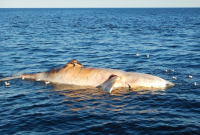Support strong Canadian climate journalism for 2025
As the North Atlantic right whale nears the end of a year of dangerously high mortality, federal ocean regulators are calling for it to remain listed as endangered, according to a report released Friday.
Less than 500 of the right whales exist, and scientists have said at least 15 of them have died since the spring off the coast of U.S. and Canada. Many of the deaths were attributed to vessel strikes and entanglement in fishing gear.
The National Oceanic and Atmospheric Administration's five-year review of the species states that the right whales are experiencing low reproduction, declining abundance and changes in the availability of food.
The review includes recommendations to protect the species, such as developing a long-term plan for monitoring the population trends and habitat use, and studying the impact of commercial fishing on right whales.
Other recommendations include prioritizing funding of acoustic, aerial and ship surveys of right whales and evaluating whether it might be necessary to modify existing protections such as ship speed rules.
The agency said in a statement that "this most recent decline and the large number of deaths in 2017 are a serious concern, and reminds us that we still have a long way to go to bring this population back to the point at which it is considered recovered." The review states that the whales also suffer due to "continued human-caused mortality" and "uncertainty regarding the effectiveness of conservation regulations."
Biologist Regina Asmutis-Silvia of Whale and Dolphin Conservation said the extension of the endangered status is good, but the animals need new protective measures more than more studies.
"We need action to prevent their extinction," she said. "Unfortunately, right whales don't need any more data for us to know they're endangered."
Researchers with NOAA and the New England Aquarium said last month that they've developed a new model to provide better estimates about the population of right whales. The agency said the number of whales declined from 482 in 2010 to 458 in 2015, following a period of slow recovery in which they increased from about 270 in 1990.
The animals appear off the New England and Canadian coasts in the spring and summer to feed. They are called right whales because they were considered by whalers to be the "right" whales to hunt — they floated when killed and produced high amounts of whale oil. As a result, their population was decimated in the whaling era.
The Associated Press




Comments